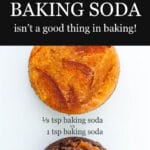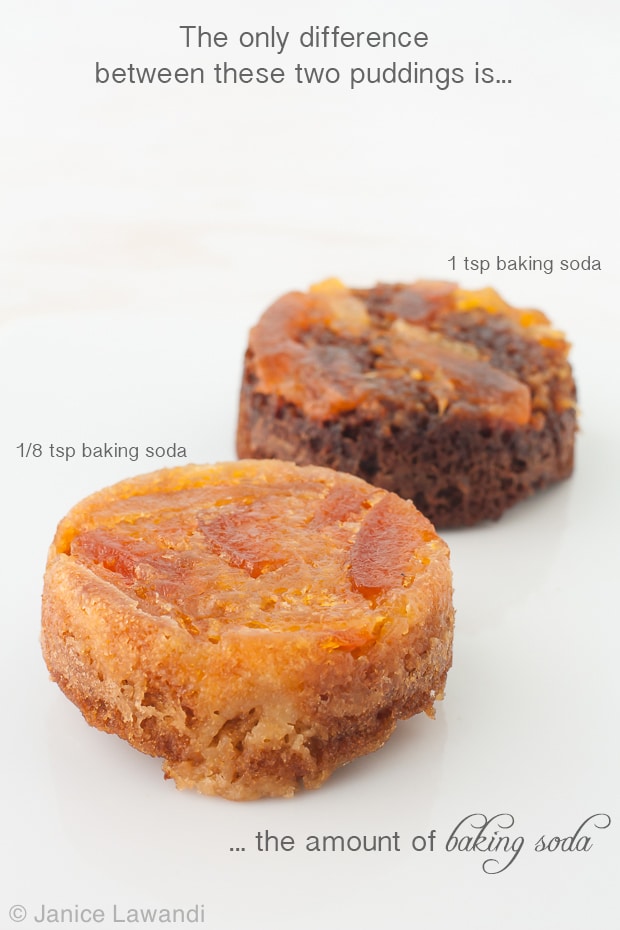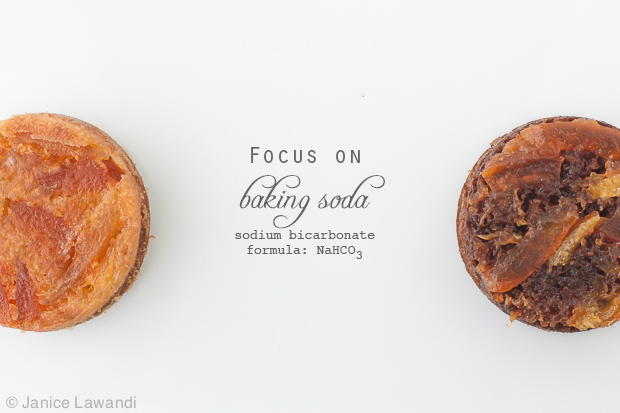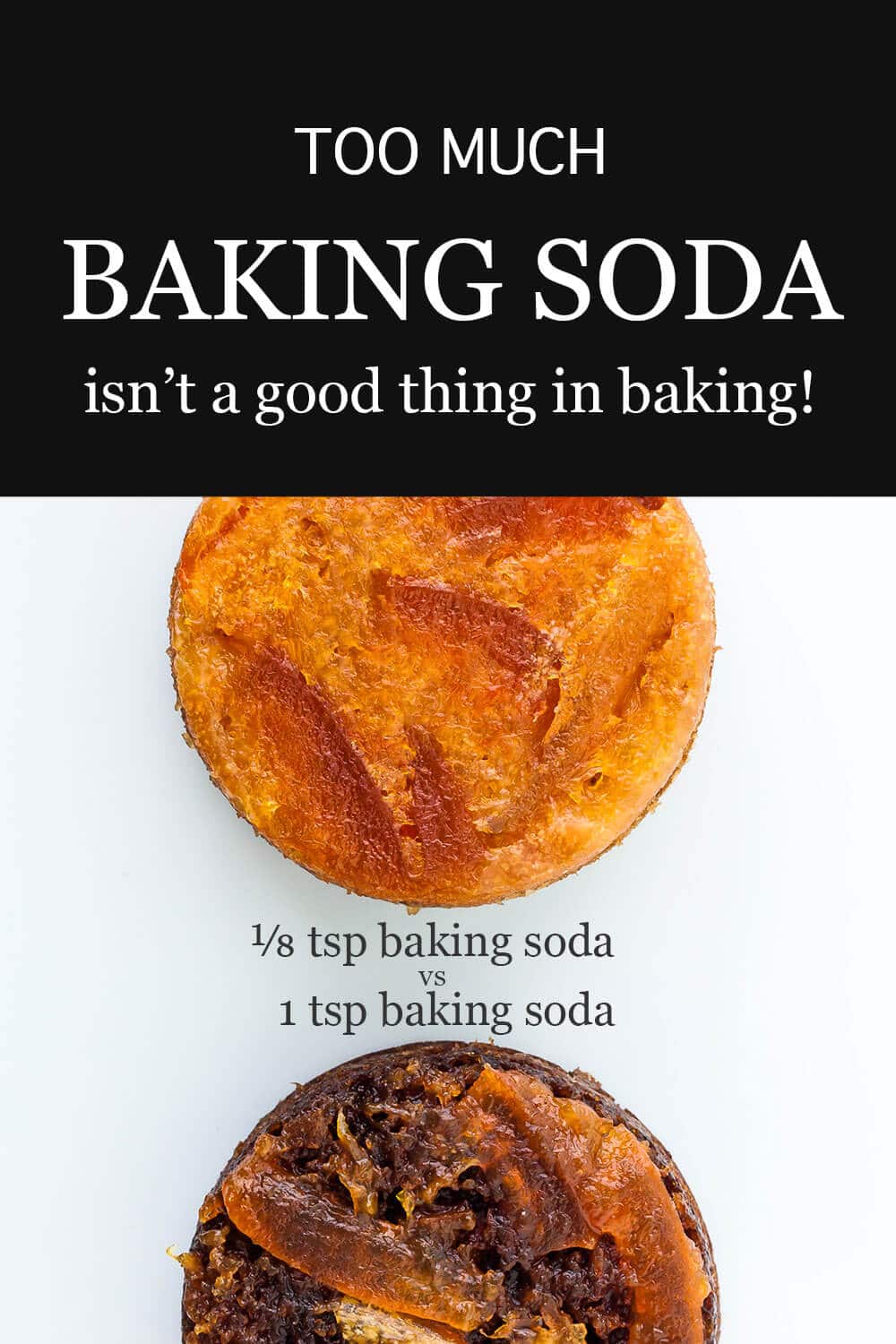what to do if you added too much baking powder

Did you add together as well much baking soda to your recipe and yous're wondering what it's going to exercise to your baked goods? Find out everything you lot need to know about baking soda in blistering: what baking soda is, what blistering soda does, what happens if y'all add together too much baking soda, does it elapse, and what happens if you use baking soda instead of baking powder?

I shared with y'all a recipe for marmalade pudding cakes, pulled from my family unit'due south recipe box. The original recipe had a lot of blistering soda, and the puddings browned significantly as they cooked. Similar a good pharmacist, I blamed the baking soda and I wanted to investigate.
To prove this, I remade the pudding cakes, modifying the amount of baking soda and adding just an 8th of a teaspoon to the second batch, instead of the full teaspoon called for in the original recipe. The 2d batch of steamed puddings were completely different: significantly lighter in color, with a firmer, spongy texture. Interesting.
Spring to:
- What is blistering soda?
- What does it do?
- What happens if y'all add also much?
- As well much baking soda causes cakes to brown and may leave a weird taste
- How much blistering soda to use in cakes and other recipes: rule of thumb
- Does it expire?
- Determination
- References
What is baking soda?
Baking soda is the common proper noun for the chemical sodium bicarbonate (or bicarbonate of soda, as the Brits like to call information technology). The chemical formula for baking soda is NaHCO3. Sodium bicarbonate is basic (as in alkaline metal) and reacts under acidic conditions to produce carbon dioxide (COii), the gas that lifts cake batters and helps your cakes rise (h2o and salt are also produced).
Sodium bicarbonate is a chemic leavener, dissimilar yeast. Yeast is a living organism, and when you feed it (like when y'all give information technology some water and some sugar), it likewise will produce gas, just through a different procedure known as fermentation: the yeast organisms consume sugar, assimilate information technology, then they produce CO2(along with other compounds similar alcohol).
To summarize, your breads rise because yeast in the bread dough eat saccharide and produce a gas, while your cakes rise because baking soda reacts with acids to produce a gas. This is also the principle behind blistering pulverization, another leavening agent.
Now, why does more or less blistering soda make the ii batches of block wait and then different? At that place's more chemistry to discuss here, like the Maillard reaction.

What does information technology exercise?
Baking soda causes baked goods to brown via the Maillard reaction
As you bake a block or bread, you obviously find a change in color as the broiled practiced turns gold brown, but you might also notice that the sweet flavours transform into something deeper, and not as sweet: French pastry chefs similar to phone call this "golden brown delicious." The change in colour/flavor from cake batter to block occurs considering of the Maillard reaction: sugars break down/transform into brownish coloured polymers and effluvious substances that contribute to the aroma and season of baked goods.
The Maillard reaction turns cakes from pale and very sweetness to golden brownish delicious. Baking soda and Maillard browning give Boston brownish bread its signature taste and look.

What happens if you add too much?
In that location's a fine line between the right amount of baking soda and the incorrect corporeality. Make certain to utilize the correct methods to measure your ingredients.
Also much blistering soda causes cakes to brown and may leave a weird sense of taste
The Maillard reaction speeds up nether bones conditions (similar when you add to a recipe a lot of baking soda, which is alkaline, i.eastward. bones). Considering the original marmalade pudding recipe had a large amount of baking soda in it, the resulting cake concoction had a college pH, and the Maillard reaction occurred faster. The puddings browned more than quickly while steaming for an hr. More than baking soda, more browning.
Unfortunately, with more than baking soda, a lot of it reacts, but some of it (the backlog) is left behind, unreacted. This lingering baking soda affects the flavor, which seems "sharper" and besides much blistering soda might cause your cakes and cookies to taste soapy even.

The puddings made with a full teaspoon of baking soda taste less like marmalade and more than like something stronger than the expected citrus flavour. That's the baking soda. The second batch of puddings had but an eighth of a teaspoon of baking soda, therefore the Maillard reaction occurred much slower. The steamed puddings accept a more familiar "golden brown delicious" look to them. The taste of the marmalade is clear, then is the succulent buttery flavour.
At this bespeak, you would think I'one thousand done with the chemistry chat, but I'm not. I have one more than thing to point out near blistering soda.
Baking soda is a tenderizer and too much baking soda affects texture
I noticed the original pudding cakes had a very tender crumb, and they were spongy and soft. On the other hand, the puddings fabricated with i eighth of the blistering soda were still spongy, simply much firmer. Once again, we can arraign baking soda. Baking soda provides lots of rise ability to the pudding cakes, but actually, I noticed that the cakes with less baking soda were more domed, while the cakes with more blistering soda were flatter, just with a more than bubbled texture on the sides and bottom.
The baking soda raised the pH of the cake batter, thereby weakening the gluten in the flour: the texture and tenderness of the cakes were affected. Weaker gluten means a looser structure, with more spread, bigger air pockets (a more than open up nibble) and tenderness. So the cakes with more than baking soda seemed to rise less, but in fact, that's because the gluten was weak and couldn't support the forming gas pockets. An adequate amount of baking soda (⅛ tsp) allowed the little pudding cakes to rising up and stay up, while an excess of baking soda caused the cakes to spread out, instead of upward.
How much baking soda to use in cakes and other recipes: rule of thumb
Likewise much blistering soda is clearly non a good affair, creating too many bubbles in cakes, causing cakes to sink, leading to over-browning, and producing an off-flavour that might even exist soapy. So how much baking soda is enough? In general, the basic rule for how much baking soda to add to a recipe is ¼ teaspoon of baking soda for each loving cup of all-purpose flour (125 grams).
In recipes where that contain large volumes of acidic ingredients, you would need ½ teaspoon of blistering soda to neutralize ane cup of a mildly acidic ingredient, like sour cream, buttermilk, or yogurt. For example, this Irish soda bread with raisins is made with 500 mL (two cups) of buttermilk and 1 teaspoon of blistering soda. Of course, this is just a guideline and recipes may vary for other reasons (pan size, presence of "heavy" ingredients like nuts and dried fruit that might require extra leavening, etc.).
Does it expire?
Baking powder does expire and can lose dominance over time, given that baking powder contains both baking soda and an acid (or two) that information technology tin react with in presence of humidity. For this reason, it is super of import to check baking pulverisation periodically to make sure it is still reactive. On the other paw, baking soda is simply sodium bicarbonate, a single compound and even if it's exposed to a little humidity from the air, it won't completely break down and lose potency the same mode baking powder does. For this reason, blistering soda does non expire.
The trouble with older containers of baking soda
Though baking soda doesn't expire, you still have to be weary when baking with a container of baking soda that has been open for months (or fifty-fifty years). Information technology'south not that the blistering soda volition suspension downwards over fourth dimension and end working, only open containers of baking soda exposed to humidity will dodder. You will have trouble incorporating clumpy baking soda into your cake batters and other baked goods, which tin can lead to clusters of baking soda in block batters and cookie doughs. These clusters will atomic number 82 to tiny patches of baking soda in your baked appurtenances, causing brown spots and larger air pockets in your broiled goods.
How to store baking soda?
Given that baking soda will lose clump if exposed to moisture, it's important to store it in a cool, dry identify, in an closed container that has a skillful seal to make sure moisture doesn't get in. Blistering soda is often sold at the grocery store in a cardboard box that, once opened, doesn't close, and so you may want to either store the box in a purse with a seal or to transfer the pulverisation to an air-tight container with a proper chapeau. This way air exposure will be minimal and your baking soda won't clump.
Decision
Baking soda is an important leavening agent in baking. Nosotros all use it and it is a vital ingredient in commercial and bootleg baking powder. But actually, baking soda does and then much more than just cause cakes to ascent. Blistering soda is alkaline, and as such, adding information technology to recipes means that it may affect the colour, season, and texture of baked appurtenances, equally does also much baking pulverisation.
References
How Baking Works, 3rd edition. Paula Figoni. Buy it on Amazon
Source: https://bakeschool.com/focus-on-baking-soda/
0 Response to "what to do if you added too much baking powder"
Post a Comment